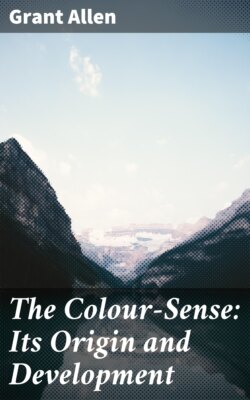The Colour-Sense: Its Origin and Development

Реклама. ООО «ЛитРес», ИНН: 7719571260.
Оглавление
Allen Grant. The Colour-Sense: Its Origin and Development
The Colour-Sense: Its Origin and Development
Table of Contents
BOSTON: HOUGHTON, OSGOOD, & COMPANY. 1879
PREFACE
CHAPTER I
INTRODUCTORY
CHAPTER II
ÆTHER-WAVES AND THEIR VARIETIES.[1]
CHAPTER III
THE ORGAN OF VISION
CHAPTER IV
INSECTS AND FLOWERS
CHAPTER V
THE COLOUR-SENSE IN INSECTS
CHAPTER VI
BIRDS OR MAMMALS AND FRUITS
CHAPTER VII
THE COLOUR-SENSE IN VERTEBRATES
CHAPTER VIII
THE COMMUNITY OF TASTE BETWEEN FLOWER-FEEDING AND FRUIT-EATING SPECIES
CHAPTER IX
THE DIRECT REACTION OF THE COLOUR-SENSE UPON THE ANIMAL INTEGUMENTS
CHAPTER X
THE INDIRECT REACTION OF THE COLOUR-SENSE UPON THE ANIMAL INTEGUMENTS
CHAPTER XI
THE COLOUR-SENSE IN MAN
CHAPTER XII
THE ÆSTHETIC VALUE OF COLOUR
CHAPTER XIII
THE GROWTH OF THE COLOUR-VOCABULARY
CHAPTER XIV
SUMMARY AND RECAPITULATION
Footnote
Отрывок из книги
Grant Allen
Published by Good Press, 2021
.....
The light-waves falling upon a body do not largely affect it, as a rule, in any way. They may occasionally be employed in bringing about slight changes of its superficial molecules, but they do not penetrate deeply or work conspicuous rearrangements of its whole substance. Nevertheless, the power of discriminating them may indirectly benefit an animal organism. If a jelly-fish, swimming at the water’s top, has eyelets upon which the incident light-waves produce distinct effects, it may be warned of the approaching enemy, or informed of passing prey, by having the path of the æther-waves cut off from above. Still more valuable will the nascent sense become, if, instead of being restricted to the full force of directly incident undulations, it is capable of being impressed by reflected waves. In this case, not only will the creature be conscious of objects passing between it and the source of light, but it will be able to receive varying stimulations from all surrounding objects upon which the light falls. The more highly developed its sight becomes (for we may now use the language of ordinary life without fear of ambiguity), the more clearly will it be affected by the beams which are twisted about and returned upon space from every neighbouring body. Until at last that very fact in the light-waves which made them originally so unimportant—the fact that they glance off every object they hit like a ball rebounding from a wall—gives them, in our eyes, the greatest value, by enabling us to discriminate from a distance the shape and texture of all we see, without the trouble of actual examination by the hands and fingers.
But this specialised sense is hardly likely to spread itself over the whole body, like the sense of heat and cold. Not only should we derive no advantage from being all eye, but we should be positively incommoded rather than benefited by such an arrangement. It will only be in certain special spots or ocelli that the perception of light will probably begin; and as the sense strengthens, we shall find these spots becoming fewer and fewer, until in the approximately perfect organisms they are reduced to the two conspicuous orbs which we commonly call eyes. All such questions, however, must be left over for a while, until we come to examine the development of the rudimentary vision. At present we must hurry on to reach our proper subject—the objective nature of colour.
.....